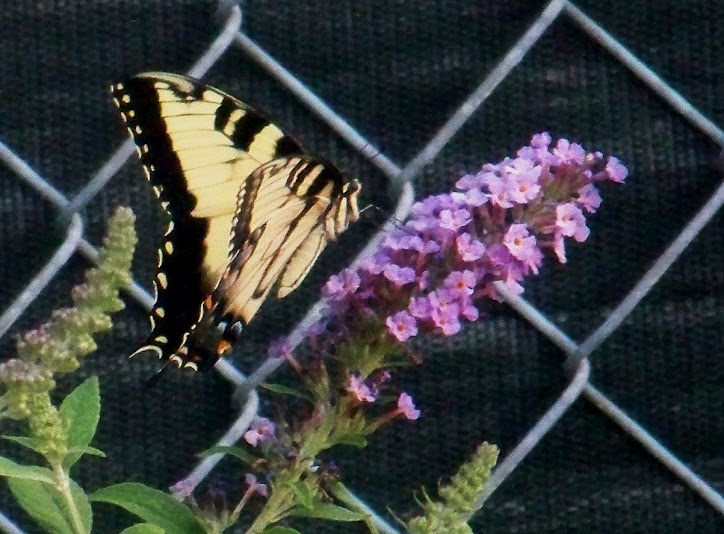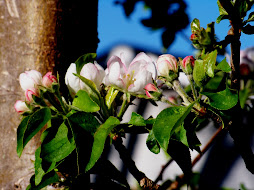Hi Folks!
 Thinking about planting strawberries this year? Me too! Jonnsons Garden Center here in Wichita just sent me their monthly newsletter - on real paper (no e-mail for them). They're saying to Plant Strawberries around the Middle of March in our South Central Kansas Area. We're in the USDA Plant Hardiness Zone 6b. That means you have about 2 or 3 weeks before planting time Here - and a little more time if you live in one of the colder zones. Usually strawberries go fast at the nurseries so don't dilly dally if you want to get Strawberries in this year.
Thinking about planting strawberries this year? Me too! Jonnsons Garden Center here in Wichita just sent me their monthly newsletter - on real paper (no e-mail for them). They're saying to Plant Strawberries around the Middle of March in our South Central Kansas Area. We're in the USDA Plant Hardiness Zone 6b. That means you have about 2 or 3 weeks before planting time Here - and a little more time if you live in one of the colder zones. Usually strawberries go fast at the nurseries so don't dilly dally if you want to get Strawberries in this year.
It's been years since I've planted home grown strawberries. I remember when my mother asked me to dig up the ground on the side of our garage on our Western Kansas farm, so we could plant a decent sized patch of "Everbearing" Strawberries. Complements of Henry Fields and the mailman who had dropped off at our box down the road apiece.
Did I get out a garden spade or fork from Dad's collection of digging tools kept in the back west corner of the garage? Nope. Even as a 15 year old, I knew I would need something a little more heavy duty. I grabbed a "sharp shooter" and Dad's Pick-Ax. One to crack open the hard pan and the other to jump-up on... to cut through a few inches of badly compacted soil.
My big brother sometimes parked Dad's International tractor here just long enough to catch noon "dinner" as we called it out in Western Kansas and a nap on the living room couch before going back out to the field until evening time.
After my brother left home, I usually got the job of occassional field work but so help me, I never could make a straight furrow! I just didn't have the nack for it as hard as I tried. Dad just loaned me out for hire to the neighbors - when they were desperate for a dependable field hand. I was dependable. I just wasn't very good!
But, I did managed to do well enough to buy my first car at 16. Would you believe "on Lay-A Way! A wonderful 1953 Oldsmobile Rocket. How I loved that big green Tank! I was told It originally was a race car. Big engine - 4 barrel carborator- White side walls. Done 95 in a quarter. We had a favorite Highway hill just North of town to test our cars on. Very dangerous at the bottom. But we did it anyway. We weren't perfect Then either!
Anyway, I got the Strawberries planted in Mom's little plot. They grew pretty well too - even if my Dad had (on occassion) used the area to set-up a portable cement mixer along side a pile of course sand and several sacks of powdery gray cement. And splashed a little around on the ground sometimes. My Dad did all his own remodeling with some help from neighboring farmers and friends.
I was just 6 when my Dad bought some land with an old gray two-story house - once owned by a retired Bootlegger who shall remain unnamed.
My Dad and the neighbors completely remodeled the old house, outside and in. Lowered the roof. Put on new shingles, new chimney, Stucco, windows, and dug a basement (for Tornadoes you understand.
He done everything himself - except for the electrical. Right down to sanding the old wood living room floor where a ring of cigarette burns marked "gambling ring where the old bootlegger and his friends played "Craps" every Saturday night, casually stumping out their cigars and cigarettes. I guess ashtrays were scarce or he never had enough to go around for his Saturday night "friends".
Long afterwards, we kids would find old dried out fruit jars buried in the side of the creek bed and hidden in mud-filled old rusted car hulls setting along the creek bed. I think my Mother insisted Dad should move the house up on the Other side of the hill where the land was pristine and not littered with vintage whiskey bottles and fruit jars - once used for the same purpose.
Which he did. So that brings us back to the strawberry bed... Would you believe... I like a good story...and I just had to pass it on to you good folks!
The soil should be well drained, fertile and lightened with compost etc.
Strawberries like "Sandy Soil". It provides good drainage. It's also good to mix in a little dried manure and compost or leaf mold to lighten up the soil.
I wouldn't recommend the stones and ocasionally large pebbles along with the cement dust that got strewn around - during the previous remodeling work in my mothers Strawberry Bed. It sure made for hard digging!
However, the strawberry bed well drained!
Strawberries also like lots of water. At least the equivalent of 2 or 3 inches of rain a week. It didn't rain much then - and it still doesn't. We lived about 80 miles east of the Colorado desert! I carried several milk buckets of water to them every day - until Dad decided to get "Up Town" and buy a rubber hose! It wasn't that my Dad was that frugal, he just hadn't seen the need before. If your wheat fields don't get rainwater, your just out of luck! Garden hoses were not to practical for a western Kansas farmer because their Wheat fields, Corn and Sorgam crops were their garden!
I'm not sure how we prepared the strawberry bed for winter or even if we did, but one of the best ways to do it is to pile about a foot or two of wheat straw over them in the late fall. Then carefully pull the straw away from each plant in the spring. Otherwise, they will probably all freeze out when it gets 5 or 10 below next winter. Or even colder in North West Kansas where I grew up! It wasn't called "Little Siberia" for nothing!
Watering and Planting Strawberries
Pick a cloudy day if you can to put in your new plants, to prevent withering of the plants from the hot sun. "Water in" your plants right after planting them.
From then on, "soaker hoses are good for gentle, deep watering - and save you money in the long run. Your strawberry bed should be deep watered at least once a week. Never let them dry out. But be careful. Frequent standing water will cause the plants to rot. Best time to water? Early morning which gives the plants time to dry off before evening. Otherwise they can succumb to Mildew and Fungus'.
Mulch your strawberries plants with Straw or Pine Needles. If you have a pine tree in the front yard, you have plenty of those! Strawberries as well as most acid living garden vegetables, like the acid pine needles produce in the soil. Mulches such as these keeps the soil cool, keeps moisture in and and protect the berries from picking up dirt and mud.
After the last harvest, cover the plants over (before the first frost in the Fall) to protect them from freezing out in the deep of Winter. The colder your area, the deeper the mulch should be. It might be from a few inches to a foot or two in the far Northern areas of the US.
I Repeat
Remember, Mulching is essential for strawberry plants because it keeps the soil cool, controls weeds, retains moisture and keeps the strawberries from laying on the bare soil and rotting. And keeps them from freezing out in the Winter. If you want a Good crop of Strawberries - ya' gotta' mulch! Place the mulch in the rows between the plants when you plant them. I don't like Wood Chips because they sometimes support a crop of Toad Stools, especially in the Spring. And they take forever to break down - as do dry uncomposted leaves. The mulch should be removed from the plants in the spring. Just gently pull it back from the strawberry plants back onto the rows between.
Cloning Strawberries
To make new "starts" to enlarge the bed, or give to friends and neighbors, get several 6 -inch lengths of clothes hanger wire or such, and make a hairpin shape out of them. Pin down a runner in several places in the soil (about every 6 to 8 inches). Pile a little soil on top of the pinned area. Keep watered. The best time to do this is in the spring or fall.
In a few weeks you will be able to cut the rooted sections apart with no harm to the "mother" plant. You have just produced a "clone" - without the laboratory!
It is my understanding that a similar process is done to reproduce Hybrid and Open Pollinated Tomatoes, over and over, every year. I was amazed when I first learned this. Tomato "cuttings" are made from the Parent plant and rooted in a light soil mix. In a kind of "Topiary" or Bell Jar environment.
I suppose a ceramic pot or an old fruit jar would work just as well if you kept the cuttings damp with daily misting and gave them fresh air for an hour or so a day. When you lightly tug on them amd feel resistance, they probably have new roots. Keep them near a well lighted window but never in the direct sun. When roots appear, repot or plant in your new strawberry plot.
Three Types of Strawberries
June Berries - Bear heavy in June for 2 or 3 weeks
Everbearing - Pick in June and throughout the summer until they stop bearing.
Day-Neutral - Same as Everbearing
So, better hurry down to your local nursery to get some of those Strawberry sets if your in South Central Kansas. A little later if your further North, Strawberries should be planted just after the last hard freeze in the spring. Late April is usually OK. Late May or June is a little late. Strawberries do not love Hot weather. Expect the first year to have sparce production. That's just the nature of Strawberries! The second year will be a good producing year for you if they have been well cared for the year before.
Support Your Local Nursery
So check out your local plant nursery. Chances are their prices are just as good as the Big Box store. And you can't beat the quality and service! And the Knowledge!
Warning! Big Box stores will set their plants out very early. That does not mean you should plant them when you buy them. At least in the first of the season. You plants may either die from the cold or be stunted and wont show any growth for weeks. Actually, planting too early without proper protection from the cold can set back some plants for several weeks! This is especially true for warm weather plants such as Tomatoes and Peppers.
So visit your local Plant Nursery. You'll be glad you did!
Tell 'em GrandBob sent you.
Bob
GrandBob
http://grandbobsgarden.blogspot.com/
http://beginninggardeners.blogspot.com/
http://groups.Yahoo.com/Group/HaysvilleFarmandGardenNews



